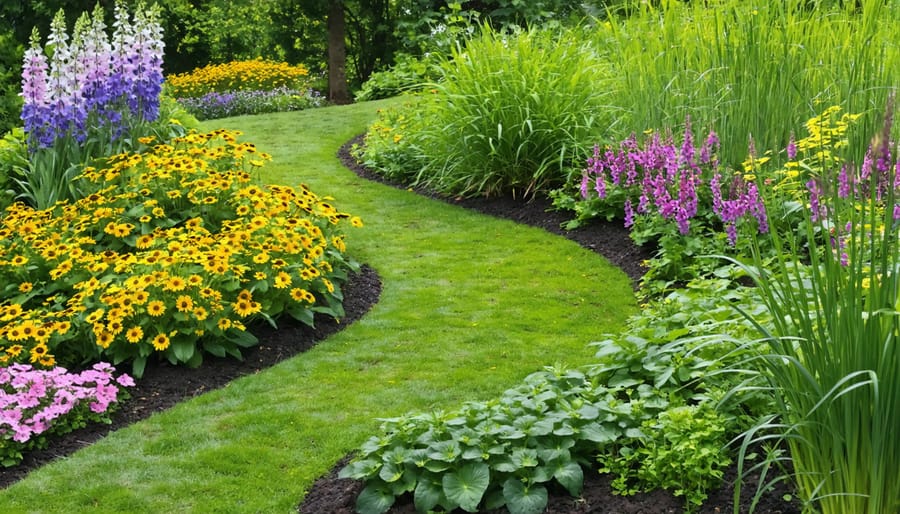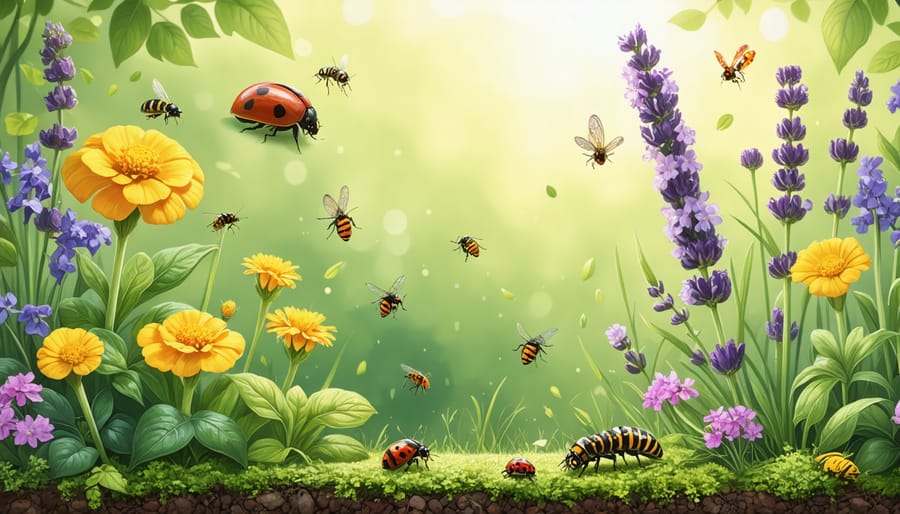Stick your finger an inch deep into the soil before watering – moist soil means your plant doesn’t need more water yet. Master proper perennial garden care by learning to recognize the telltale signs of overwatering: yellowing leaves, root rot, and fungal growth. While many gardeners worry about underwatering, overwatering actually kills more plants by suffocating roots and creating the perfect environment for deadly pathogens. Proper drainage and understanding your plant’s specific water needs transforms anxious watering routines into confident plant care. Watch for early warning signs like consistently wet soil, moldy surface growth, and drooping leaves – these signal it’s time to adjust your watering schedule before serious damage occurs. The key to thriving plants isn’t more water, but rather learning to water deeply and less frequently, allowing soil to partially dry between waterings.
Signs Your Perennials Are Getting Too Much Water
Visual Plant Symptoms
The first signs of overwatering often appear in the leaves. You’ll notice yellowing or browning leaves, particularly on the lower portions of the plant. Unlike drought-stressed plants, these leaves often feel soft and limp rather than crispy. Many gardeners are surprised to learn that wilting can actually be a sign of too much water, not too little.
Another telltale symptom is edema, where blisters or bumps form on leaves because cells have taken in more water than they can handle. You might also spot water-soaked spots on leaves and stems, or notice leaves dropping while still green.
Below the soil surface, roots tell an important story. Healthy roots should be firm and white or light tan. If you gently pull up a struggling plant and find dark, mushy roots with an unpleasant smell, you’re likely dealing with root rot. The soil itself might have a sour odor and appear consistently wet or show signs of mold growth on the surface.
Watch for stunted growth and a general decline in plant vigor – these are often late-stage symptoms that require immediate attention.

Soil and Environmental Indicators
The soil holds many clues to overwatering problems. When you squeeze a handful of soil from an overwatered plant, it feels consistently wet and may form a tight ball. Healthy soil should crumble easily and feel slightly damp, not waterlogged. Look for a green or white crusty layer on the soil surface – this algae or fungal growth is a telltale sign of excess moisture.
Environmental indicators are equally revealing. Check for mushrooms sprouting around your plants, as fungi thrive in overly wet conditions. A distinctive musty or rotting smell coming from the soil is another warning sign, indicating poor oxygen circulation and decomposing roots.
The surrounding area might also show signs of trouble. Water pooling on the soil surface long after watering, or water constantly seeping from drainage holes, suggests you’re giving your plants too much to drink. In container gardens, watch for water marks or mineral deposits on pot surfaces – these white, chalky stains indicate frequent oversaturation.
Pay attention to these soil and environmental signals early on, as they’re often the first warning signs before visible plant damage occurs.
The Science Behind Smart Watering
Root Health and Water Uptake
Plant roots need a delicate balance of both water and oxygen to thrive. When soil is properly moist, roots can easily absorb water and essential nutrients while also taking in oxygen through small air pockets in the soil. However, when we overwater our plants, these vital air spaces become filled with water, creating a suffocating environment for roots.
Think of roots as tiny straws that need both a drink and a breath. In waterlogged soil, roots literally can’t breathe, which leads to root stress and eventually root rot. The lack of oxygen causes root cells to die, and the constantly wet conditions create the perfect environment for harmful fungi and bacteria to multiply.
Healthy roots should appear firm and white or light tan in color. When roots are drowning in excess water, they become brown, mushy, and develop an unpleasant smell. This damage isn’t just confined to the roots – it affects the entire plant’s ability to take up nutrients and water, leading to yellowing leaves, stunted growth, and eventual plant death if not addressed.
The good news is that most plants are quite resilient, and if you catch overwatering early, you can usually help your plant recover by adjusting your watering routine and improving soil drainage.
Soil Drainage Basics
Understanding your garden’s soil drainage and management is crucial in preventing overwatering issues. Different soil types behave uniquely when it comes to water retention and drainage. Sandy soils drain quickly but might not retain enough moisture, while clay soils hold water longer and can become waterlogged easily.
To test your soil’s drainage, try this simple method: dig a hole about 12 inches deep and fill it with water. If the water takes more than 12 hours to drain completely, you likely have poor drainage that could lead to overwatering problems. Good soil should feel slightly moist but never soggy when squeezed in your hand.
Adding organic matter like compost can significantly improve drainage in both sandy and clay soils. It creates air pockets that allow excess water to flow through while retaining just enough moisture for healthy root development. Think of your soil as a sponge – it should hold water without becoming waterlogged.
For container gardens, always ensure your pots have adequate drainage holes and use well-draining potting mix. A layer of gravel or broken pottery pieces at the bottom can help prevent soil from clogging drainage holes, though don’t overdo it as this can actually hinder proper drainage.

Smart Watering Techniques
Timing and Frequency
Proper timing and frequency of watering are crucial for maintaining healthy perennials. Following a seasonal watering schedule helps prevent overwatering while meeting your plants’ changing needs throughout the year.
During the growing season (spring and summer), most perennials need watering when the top 1-2 inches of soil feels dry to the touch. This typically means watering deeply once or twice a week, rather than frequent shallow watering. However, this can vary depending on your climate, soil type, and specific plant varieties.
Morning watering is ideal, giving plants time to absorb moisture before the heat of the day. Avoid evening watering, which can leave foliage wet overnight and encourage fungal growth. During particularly hot spells, you might need to water more frequently, but always check the soil moisture first.
In fall and winter, most perennials enter dormancy and require significantly less water. For these seasons, reduce watering to once every 2-3 weeks, or even less in regions with regular rainfall. Desert perennials and drought-resistant varieties might need water only monthly during their dormant period.
Remember that newly planted perennials need more frequent watering than established plants. For the first few weeks after planting, water every 2-3 days, gradually extending the time between watering as roots establish themselves.
Tools and Methods
Selecting the right tools and methods for watering your plants is crucial for preventing overwatering while ensuring optimal growth. A moisture meter is an invaluable tool that takes the guesswork out of watering by providing accurate readings of soil moisture levels at various depths. Simply insert the probe into the soil, and the meter will indicate whether your plants need water.
For controlled watering, consider using self-watering containers or drip irrigation systems. These tools deliver water directly to the roots while maintaining consistent moisture levels. A watering can with a long spout or a hose with an adjustable nozzle allows for precise water delivery without splashing leaves or creating excess surface moisture.
The finger test remains one of the most reliable methods for checking soil moisture. Insert your finger about an inch into the soil – if it feels dry at that depth, it’s time to water. For larger gardens, installing a rain gauge helps track natural precipitation and adjust your watering schedule accordingly.
When watering, always aim for the base of the plant rather than overhead. This technique prevents water from sitting on leaves and reduces the risk of fungal diseases. Consider using mulch around your plants to help regulate soil moisture and reduce evaporation. Terra cotta water probes can also provide steady, controlled moisture release for indoor plants or containers.

Recovery Steps for Overwatered Plants
If you’ve discovered your perennials are showing signs of overwatering, don’t worry – there’s still hope! The first step is to immediately stop watering and give your plants time to dry out. Remove any standing water from saucers or catch basins beneath the pots.
For container plants, gently remove them from their pots and inspect the root system. Healthy roots should be firm and white or light-colored. Trim away any mushy, brown, or black roots using clean, sharp pruning shears. Repot the plant in fresh, well-draining potting soil in a container with adequate drainage holes.
For garden-grown perennials, improve drainage by creating small channels around the plant base to direct water away. Adding organic matter like compost or bark mulch can help improve soil structure and drainage. Just be careful not to pile mulch against plant stems, as this can trap moisture.
Consider moving affected plants to a sunnier location to help excess water evaporate. Remove any yellowed or dying leaves to reduce the plant’s stress and prevent fungal growth. If soil feels compacted, gently aerate it using a garden fork, being careful not to damage the root system.
Moving forward, always check soil moisture before watering. Insert your finger about an inch into the soil – if it feels damp, wait before watering again. Remember that most perennials prefer consistent moisture rather than wet conditions.
Protecting your plants from overwatering is simpler than you might think. By paying attention to the signs – like yellowing leaves, root rot, and soggy soil – you can catch problems early and adjust your watering routine accordingly. Remember that most plants prefer consistent but moderate moisture levels, and it’s always better to underwater than overwater. Make checking soil moisture part of your daily garden routine, and don’t forget to factor in rainfall and seasonal changes when planning your watering schedule. With proper drainage, the right pot size, and mindful watering habits, your plants will thrive and reward you with healthy growth. Trust your instincts, learn from experience, and remember that every garden is unique – what works for one plant might not work for another. Here’s to growing a lush, vibrant garden with just the right amount of water!




